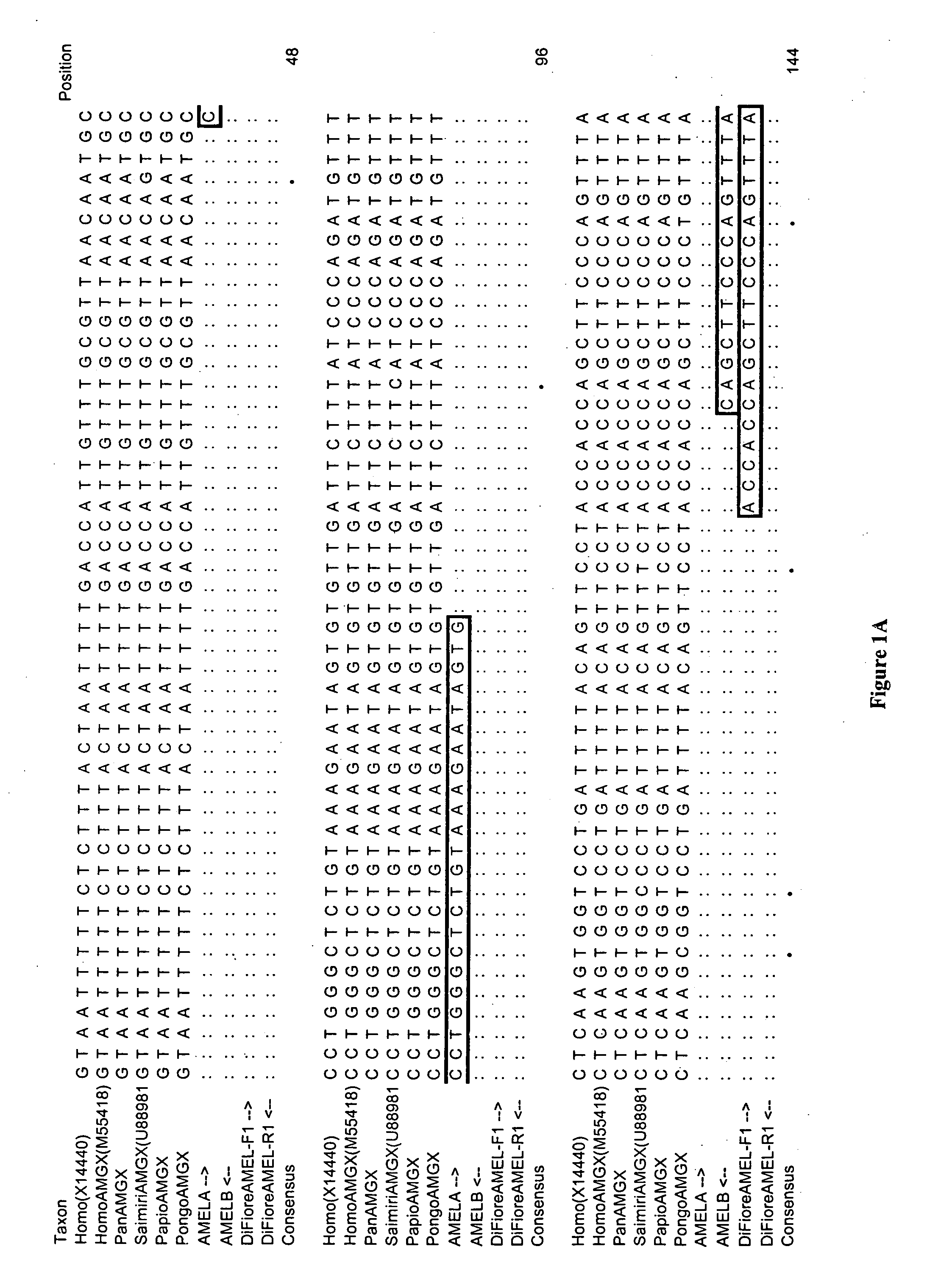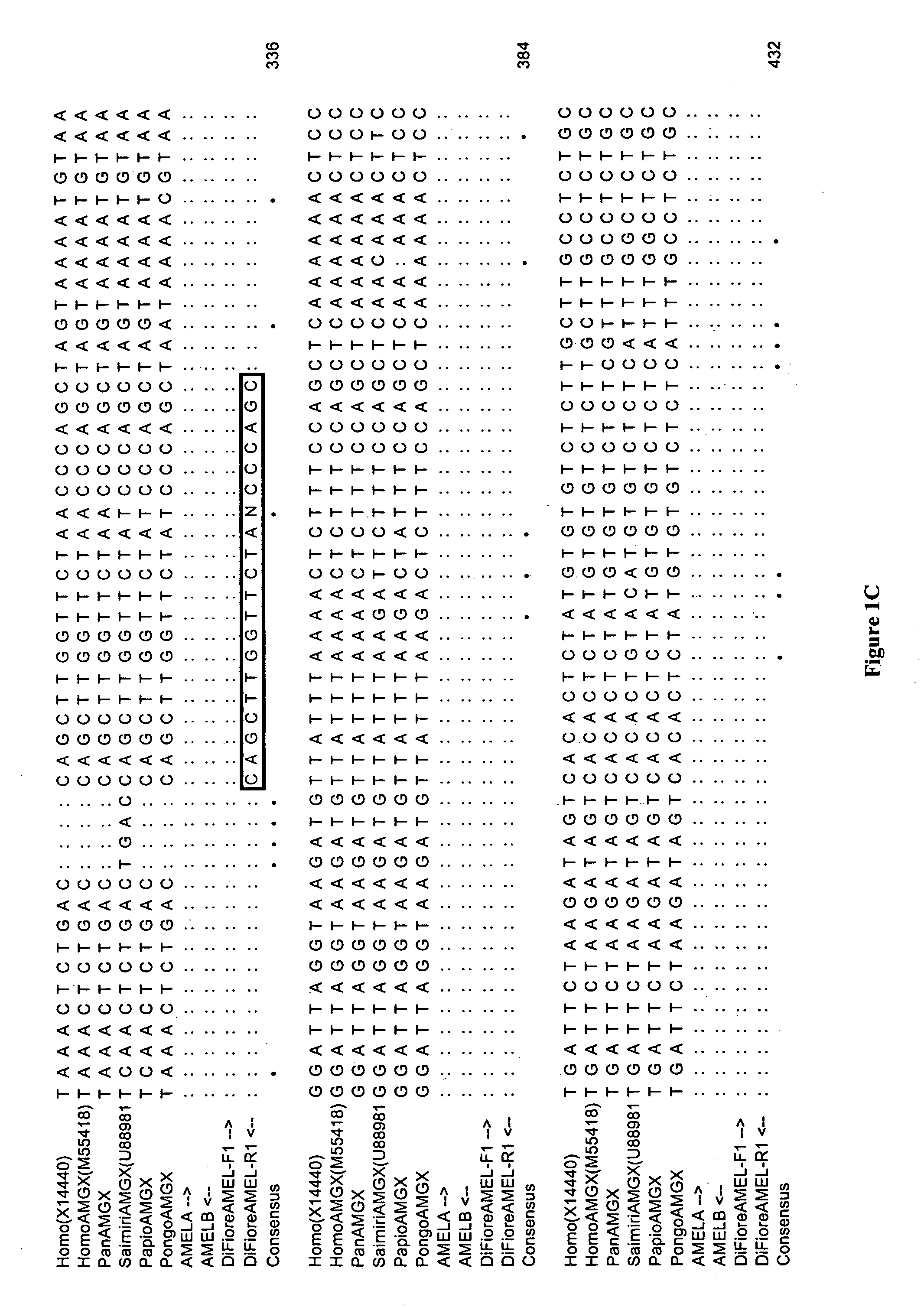Assay for determining the sex of primates
- Summary
- Abstract
- Description
- Claims
- Application Information
AI Technical Summary
Benefits of technology
Problems solved by technology
Method used
Image
Examples
Example
Example 1
Design Of Anthropoid Primers
[0061] Based on published sequence data for primates, PCR primers were designed to amplify small portions of the amelogenin X and SRY genes. The goal was to create a set of universal primers, applicable across most primates.
[0062] DNA sequences for the X chromosome copy of the amelogenin gene for Homo (SEQ ID NO: 1 and SEQ ID NO: 2) (humans), Pan (SEQ ID NO: 3) (chimpanzees), Saimiri (SEQ ID NO: 4) (squirrel monkeys), Papio (SEQ ID NO: 5) (baboons), and Pongo (SEQ ID NO: 6) (orangutans) downloaded from GenBank were aligned and presented in blocks of 48 bases, as shown in FIG. 1. Single black dots represent mismatches across taxon and / or primer sequences (these mismatches are what can prevent PCR primers from binding to sample DNA). The sequences of Sullivan et al.'s AMEL-A primer (SEQ ID NO: 7) and complement (SEQ ID NO: 8) of the AMEL-B primer (Sullivan et al., “A Rapid and Quantitative DNA Sex Test: Fluorescence-based PCR Analysis of X-Y Hom...
Example
Example 2
Collection Of Biological Samples
[0067] Genomic DNA for a variety of platyrrhine primates (New World monkeys) was extracted from various field-collected source material (blood, tissue, hair, and feces) using commercially available DNA extraction kits (e.g., QIAgen™ DNeasy Tissue Kits and QIAmp™ DNA Stool Mini Kits). DNA samples for the remaining taxa were provided by colleagues in the Molecular Anthropology Laboratory at New York University. In all, 77 samples from 38 primate genera were examined, as shown in Table 1. The Lagothrix fecal sample was desiccated in silica gel, while Ateles fecal samples were collected and stored in RNAlater™ (Ambion). The assay was also tested and worked on Papio sp. fecal samples stored in RNAlater™ (Ambion) and on Leontopithecus rosalia hair samples that were collected and stored in plastic envelopes with no desiccating agent or preservative. TABLE 1Primate samples sex-typedTaxonomic Group / SampleReportedAssignedGenus and SpeciesSource1,2Ty...
Example
Example 3
Multiplex PCR With Anthropoid Primers
[0068] Multiplex PCR with primers SEQ ID NO: 9, SEQ ID NO: 11, SEQ ID NO: 32, and SEQ ID NO: 34 provides an unambiguous and rapid sex determination assay that is broadly applicable across anthropoid primates.
[0069] Varying subsets of the samples listed in Table 1 amplified relatively cleanly in a range of early PCR trials during which different annealing temperatures and primer and magnesium concentrations were experimented with, as well as with several alternate primer oligonucleotides slightly different from those described herein. Throughout all of these optimization trials, the basic assay gave consistently good results with respect to sex determination.
[0070] Following optimization, the full set of samples was run. The multiplex PCR mix consisted of 2.5 μL of Mg-free 10× Promega™ PCR Buffer, 2.0 μL of 10 mM dNTP mix (2.5 mM each dNTP, Promega™), 1.5 μL of 25 mM MgCl2 (Promega™), 1 μL of 100× BSA (10 mg / mL) (New England Biolabs o...
PUM
| Property | Measurement | Unit |
|---|---|---|
| Fraction | aaaaa | aaaaa |
| Melting point | aaaaa | aaaaa |
| Fraction | aaaaa | aaaaa |
Abstract
Description
Claims
Application Information
 Login to View More
Login to View More - R&D
- Intellectual Property
- Life Sciences
- Materials
- Tech Scout
- Unparalleled Data Quality
- Higher Quality Content
- 60% Fewer Hallucinations
Browse by: Latest US Patents, China's latest patents, Technical Efficacy Thesaurus, Application Domain, Technology Topic, Popular Technical Reports.
© 2025 PatSnap. All rights reserved.Legal|Privacy policy|Modern Slavery Act Transparency Statement|Sitemap|About US| Contact US: help@patsnap.com



